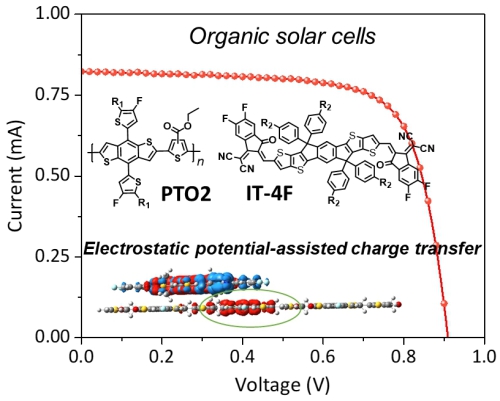In recent years, the field of organic solar cells (OPV) has achieved rapid development, and its photoelectric conversion efficiency has exceeded 15%, showing a bright application prospect. Understanding the charge transfer mechanism in OPV from the chemical structural characteristics of photoactive materials, especially the driving force source of exciton dissociation under low energy loss, is of great significance for the design of novel materials to improve battery performance.
With the support of the Chinese Academy of Sciences and the National Natural Science Foundation of China, Yao Huifeng and others from the Hou Jianhui research group of the Polymer Physics and Chemistry Laboratory, Institute of Chemistry, Chinese Academy of Sciences and others conducted related research on the structure-activity relationship between the organic photovoltaic molecular chemical structure and the charge generation mechanism. In the previous work (Chin. J. Chem. 2018, 36, 491-494), the researchers found that the molecular surface electrostatic potential (ESP) of the electron donor and electron acceptor in OPV is quite different, which promotes the charge Generate efficiently.
Recently, Yao Huifeng et al. Designed a novel polymer donor material PTO2, and studied in detail the effect mechanism of molecular surface ESP on the charge transfer process. The results show that there is a significant ESP difference between PTO2 and the non-fullerene acceptor material IT-4F. The corresponding intermolecular electric field provides the driving force for exciton dissociation and promotes charge transfer. The battery based on this has a highly efficient charge Generation efficiency; at the interface between PTO2 and the fullerene derivative receptor, the difference in ESP is relatively small, and charge transfer requires the assistance of an additional electric field.
In addition, the researchers and the collaborators of Linköping University and Lund University in Sweden have carried out corresponding research on devices and photophysics, which has important support for ESP theory. This work establishes the relationship between the molecular structure and the charge transfer process, and provides new ideas for the design of high-efficiency photovoltaic materials. Related research results were published in the recent "Journal of the American Chemical Society" (J. Am. Chem. Soc. 2019, 141, 7743-7750).

ESP differences promote the formation of charge transfer states
Face Masks,Medical Face Masks,Ear Loop Face Masks,Medical Grade Face Masks
Henan Diyi Medical Technology Development Co.,Ltd. , https://www.diyimedical.com